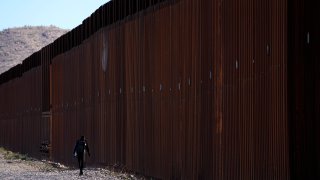
Hundreds of dates are written on concrete-filled steel columns erected along the U.S. border with Mexico to memorialize when the Border Patrol has repaired illicit openings in the would-be barriers. Yet no sooner are fixes made than another column is sawed, torched and chiseled for large groups of migrants to enter, usually with no agents in sight.
The breaches stretch about 30 miles (48 kilometers) on a washboard gravel road west of Lukeville, an Arizona desert town that consists of an official border crossing, restaurant and duty-free shop. The repair dates are mostly since spring, when the flat desert region dotted with saguaro cactus became the busiest corridor for illegal crossings.
A Border Patrol tour in Arizona for news organizations, including The Associated Press, showed improvements in custody conditions and processing times, but flows are overwhelming. Chaotic scenes, including when daily arrivals averaged more than 7,000 across the border a week in December, are catnip for conservatives in Congress who want major limits on asylum. The numbers have nudged the White House and some congressional Democrats to consider major limits to asylum as part of a deal for Ukraine aid.
As Homeland Security Secretary Alejandro Mayorkas left closed-door talks with congressional leaders Friday, dozens of migrants from Senegal, Guinea and Mexico walked along the Arizona border wall built during Donald Trump's presidency, looking to surrender to agents. A Mexican woman walked briskly with her two daughters and five grandchildren, ages 2 to 7, after being dropped off by a bus in Mexico and instructed by guides.
Get Philly local news, weather forecasts, sports and entertainment stories to your inbox. Sign up for NBC Philadelphia newsletters.
“They told us where to go; to go straight," said Alicia Santay, of Guatemala, who waited in a Border Patrol tent in Lukeville for initial processing. Santay, 22, and her 16-year-old sister hoped to join their father in New York.
The dates when wall breaches were fixed are often bunched together, written in white letters against rust-colored steel. One cluster showed five dates from April 12 to Oct. 3. On Friday, agents drove looking for openings and found one on a column that was repaired twice — on Oct. 31 and again Dec. 5.
Smuggling organizations remove a few inches from the bottom of 30-foot (9.1-meter) steel poles, which agents say can take as little as a half-hour. Columns sway back and forth, like a cantilever swing, creating ample space for large groups to walk through. Welders often attach metal bars horizontally across several columns to prevent swinging, but there are plenty of other places to saw.
U.S. & World
Stories that affect your life across the U.S. and around the world.
Agents say it takes up to an hour to drive from Lukeville along the gravel road to discover breaches — a large chunk of time when tending to so many migrants in custody.
“Our officers and agents are responding to large groups of migrants, which means that some of our agents aren’t on the line, not really monitoring for some of those cuts," said Troy Miller, U.S. Customs and Border Protection's acting commissioner. “If we don’t have anybody to respond, then you’re going to see what you’re seeing.”
The number of daily arrivals is “unprecedented,” Miller said, with illegal crossings topping 10,000 some days across the border in December. On Monday, CBP suspended cross-border rail traffic in the Texas cities of Eagle Pass and El Paso in response to migrants riding freight trains through Mexico, hopping off just before entering the U.S. The Lukeville border crossing is closed, as is a pedestrian entry in San Diego, so that more officials can be assigned to the migrant influx.
Arrests for illegal crossings topped 2 million for the first time each of the U.S. government's last two budget years, reflecting technological changes that have increased global mobility and a host of ills prompting people to leave their homes, including wealth inequality, natural disasters, political repression and organized crime.
Miller said solutions go well beyond CBP, which includes the Border Patrol, to other agencies whose responsibilities include long-term detention and asylum screenings. On cuts in the wall, Miller said Mexican authorities “need to step up.”
Arrests in the Border Patrol's Tucson sector, which includes Lukeville, topped all nine sectors on the Mexican border from May to October, except June, according to the latest public figures. It is a throwback to the early 2000s before traffic shifted to Texas, but the demographics are much different.
Arrests of people in families neared 72,000 in the Tucson sector from Oct. 1 through Dec. 9, more than nine times the same period last year. That's a big change from when almost all migrants were adult men. Arrests of non-Mexicans topped 75,000, nearly quadruple the number from a year ago and more than half of all sector arrests.
Senegalese people accounted for more than 9,000 arrests in Tucson from Oct. 1 to Dec. 9, while arrests of people from Guinea and India each topped 4,000. Agents have encountered migrants from about four dozen Eastern hemisphere countries.
Agents who pick up migrants near the wall drive them to Lukeville to have photos taken on a mobile phone that starts their processing. They drive about 45 minutes to a station in Ajo that was built to detain 100 people but housed 325 on Friday. Some are bused to other Border Patrol sectors but most are sent to Tucson, about two hours away.
At a sprawl of white tents near Tucson International Airport that was built for about 1,000 people, some migrants are flown to the Texas border for processing. Others are released within two days, as mandated by a court order in the Tucson sector. CBP policy limits detention to 72 hours.
Most are released with notices to appear in immigration courts, which are backlogged with more than 3 million cases. Some are detained longer by U.S. Immigration and Customs Enforcement.
The tents are a far cry from 2021 in Donna, Texas, where more than 4,000 migrants, largely unaccompanied children, were held in a space designed for 250 under COVID-19 restrictions. Some stayed for weeks, relying on sleeping pads and foil blankets. In 2019, investigators found 900 people crammed in a cell for 125 in El Paso, with detainees standing on toilets for room to breathe. They wore soiled clothing for days or weeks.
Discussions in Congress may produce the most significant immigration legislation since 1996. Potential changes include more mandatory detention and broader use of a rule to raise thresholds for initial asylum screenings. While the higher screening standard has been applied to tens of thousands of migrants since May after entering the country illegally, they are not used in the Border Patrol's Tucson sector due to extraordinarily high flows.



